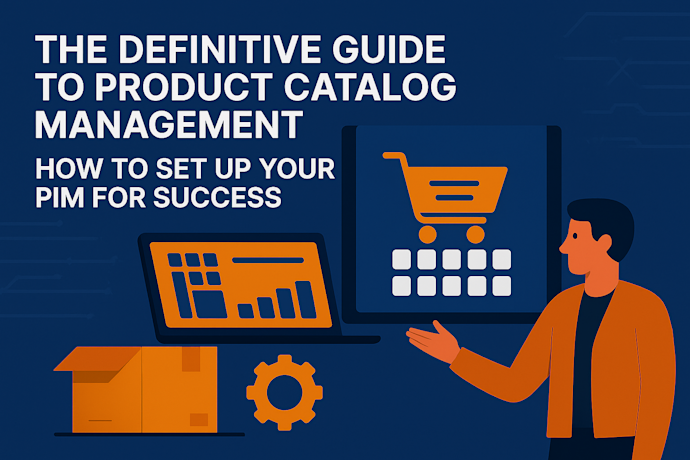- Measuring EmissioRole of PIM and ERP in Emissions Trackingns Data on Products and Services
- Role of PIM and ERP in Emissions Tracking
- Third-Party Tools and External Emissions Data
- Using product emission data to inform decision-making
- Making sustainability data useful for marketing purposes
- Repurposing corporate-level emissions data for marketing purposes
- A coherent data strategy for the modern sustainable brand
In today’s commerce landscape, sustainability isn’t just a buzzword — it’s a measurable, data-driven responsibility. For modern brands, tracking and reducing emissions requires more than corporate pledges; it demands the right technology stack. By combining systems like PIM, ERP, and composable commerce platforms, businesses can capture accurate emissions data, make informed operational decisions, and turn sustainability insights into compelling marketing stories. This article explores how to integrate sustainability into your data strategy — from product lifecycle tracking to customer engagement — to build a brand that’s both future-ready and credible.
Measuring EmissioRole of PIM and ERP in Emissions Trackingns Data on Products and Services
In order to measure emissions data, there are two particular systems that most businesses will need to deploy. The first one is an enterprise resource planning (ERP) system. This system is great for storing valuable data and automating mundane tasks such as transactions and transaction matching. However, it is often bought as a variety of modules, one of which is product lifecycle management (PLM) software. In short, a PLM is a software product managers use to design the technical requirements for their product which returns a document than can be used by the manufacturer.
Secondly, brand manufacturers, distributors and retailers, will find a PIM (product information management) system useful to scale their organisation. A PIM system allows you to store your product data into a single source of truth rather than it being dispersed across multiple channels, with different versions of the same SKU on the e-commerce website or the Google Shopping feed.
The PIM system ensures that the organization has a single view of the product information, so everyone sees the same information rather than having outdated or incomplete information across the business. This product data can include your product pricing, attributes, fact sheets, ingredients, and more.
So, to measure emissions data, both systems need to store, understand, and document the emissions data appropriately. This would mean including additional data fields in the product taxonomy to account for these measures.
Some PIM solutions we highly recommend include Pimcore and Saleslayer. Pimcore serves more complex enterprise brands with bespoke requirements, while Saleslayer works with smaller, mid-market brands requiring less customizations. Saleslayer is known for an average 6-week go-live approach as it is easier to configure and set up.
Role of PIM and ERP in Emissions Tracking
Once an item is set up in the PIM, it can sync the data via an iPaas from the PIM platform to another system such as the ERP. The PLM, on its part, can send the data of the finished goods into the PIM. Depending on the quantity and size of each part or ingredient that makes up the finished goods, the PIM could pull information from external sources such as third-party suppliers or internal sources, such as an ERP, where the emissions data lies.
Then a calculated value of the emissions data can be derived in the PIM based on different input requirements for a better understanding of the climate impact of a particular product.
Third-Party Tools and External Emissions Data
It’s worth mentioning that the PIM could also call upon other third-party data providers and carbon accounting platforms, which have dedicated modules for measuring emissions. It could also call on regulatory bodies and other data repositories, such as Open Food Facts, which can estimate emissions data.
From a logistics perspective, shipping providers are also providing emissions data related to delivery costs, which is generally collected within the e-commerce platforms, but this could then be sent to the ERP for reporting purposes.
Conclusively, integrating PLM and PIM involves transferring approved product data via APIs to document raw materials' emissions data. The centralized PIM sources data to understand a product's carbon footprint and its supply chain impact accurately.
Using product emission data to inform decision-making
Once a company understands at a SKU level the amount of carbon that a particular product emits and what the carbon footprint of that product is, the business can use this information to make decisions such as:
- “Should we sell this product?”
- “Where should we sell this product? ”
- “Where should we manufacture this product? ”
- ��“Should it be manufactured? ”
- “Where there is a lower carbon footprint or there is a potentially a higher carbon footprint?”
- “Where should they purchase the raw materials from?”
- “…etc. ”
Decisions such as this are usually made using an ERP tool for financial considerations, since it helps to create and run rules and guidelines for these key questions and decisions related to cost allocation and revenue optimization.
This tool can also be used for understanding the overall carbon footprint of a product. To take the example of a t-shirt…
The record for the T-shirt in the PIM might show a low score for sustainability but a high score for profitability, aligning with a brand's goal to offer sustainable clothing. However, another product might be highly sustainable but less profitable. It might be better for a brand to focus on products that moderately support sustainability but are also highly profitable. This way, it still fits into the company's sustainability ethos. This decision could be hard-coded into the rules engine of the ERP.
Product systems and financial systems must be fully synchronised, therefore, to calculate the sustainability of a brand’s products in the context of the business-impact of their decisions.
The business must be able to measure all input costs, including the raw materials used and the manufacturing processes. Secondly, brands should be able to measure logistical costs, from the early stages of sourcing and importing raw materials, all the way to the end-consumer, to be able to accurately calculate the environmental impact.
Making sustainability data useful for marketing purposes
For some time, brands have been making generic claims about how sustainable they are and how much they're helping the environment. But as much as brands should be measuring their emissions data with decision, they should also be targeting that information with precision.
Firstly, there's a wide variation in customers' interest in sustainability. People love to say that they would rather buy sustainable goods. Though when it comes down to it, consumers aren't really shifting their wallets to more sustainable goods. There is a wide variation in people's preferences and their willingness in paying for more sustainable goods.
Brands need a way to accurately showcase the sustainability score at the point of sale. Brands need to personalise the information based on customers' interests and find a way to better understand what their customers are looking for. They can achieve this by actively engaging with their customers, gaining valuable feedback based on their likes, dislikes and what could be done better. This would generally sit within a business's mar-tech stack.
An example of this can be seen on the Trainline website. You are able to see at the cart checkout point-of-sale how much less carbon dioxide is emitted compared to driving a car.
This simple comparison is made on the fly as the website assesses the carbon footprints of both travel options.
However, calculating the carbon footprint for complex, configurable products such as wardrobes or sofas with variations is more challenging. These variations, managed across varying product hierarchies, with many build components, could significantly alter the product's carbon footprint based on seemingly minor changes. For example if a sofa manufacturer switching to a supplier in closer proximity would require recalculating emissions data.
Brands are also increasingly using customer data platforms (CDPs) and CRMs to tailor marketing around sustainability. They segment customers by their purchasing habits related to sustainability and adjusting their strategies based on customer engagement with environmentally focused content. This approach allows brands to personalize marketing efforts and better align with their customers’ values toward sustainability.
Brands also look to implement a single source of truth for their customer data into via a customer data platform. This could be data from their CRM, DXP, past purchases, wish-lists, or their e-commerce platform.
In Pimcore's offering around CDP, there is a single source of truth for customer preferences. This can then be used to target specific marketing contexts. For example, this could be an email campaign about the launch of a more sustainable range.
It could be for retargeting campaigns around similar or complementary items from past purchases or current purchases and then pushing more sustainable products out to them. This is done by understanding customer preferences and how they align with them.
Platforms such as mParticle, Segment, and Adobe CDP are prominent players in the CDP market. CDP’s are also integrated into Digital Experience (DX) solutions such as Bloomreach and Klaviyo, with the latter featuring an email marketing platform. Other integrated platforms such as Magnolia, Pimcore and Optimizely, offer a combination of e-commerce, automation, CRM, and CDP functionalities.
To conclude, the main finding here is that it's not just about moving to a composable commerce architecture. It's about ensuring you're targeting the correct customers who are most interested in a greener, more sustainable buying experience.
Repurposing corporate-level emissions data for marketing purposes
Companies can make significant processes for their shareholders to report on emissions data across the business. This can be used not only to report back to stakeholders such as shareholders and government sponsors, etc but it can also be used to showcase their emissions data as part of their content marketing strategy.
This data could support their efforts to be more environmentally friendly in their procurement processes for logistic providers. It can also highlight a company's efforts to become more environmentally friendly, particularly in logistics and procurement. Such data is showcased in thought leadership content, PR campaigns, and media articles to underline the brand's commitment to reducing its carbon footprint.
Companies can use carbon accounting software with API-first architectures that integrate seamlessly into their existing tech stacks to manage and report emissions data properly. This allows them to consolidate data into a central data warehouse from which they can run analytics to understand their emissions across various business segments, including retail, e-commerce, and wholesale or even at a granular SKU level.
The analyzed data informs marketing strategies, creating personalized and targeted campaigns for consumers who value sustainability.
A coherent data strategy for the modern sustainable brand
Implementing a composable and modular architecture is a great way to put your data strategy together. Key systems like product information management, ERP’s and ecommerce platforms can shape a composable architecture that can track sustainability metrics across all product lifecycle stages. Having a composable best-of-breed architecture allows you to continuously improve these processes and gather the correct data for enhancement throughout the product lifecycle.
From a logistics perspective, you can buy off-the-shelf technology from shipping providers that will provide you with information on the climate impact of transporting your products. We strongly believe that standards are an important part of this, and of course, we will witness more legal requirements for companies to provide their sustainability data going forward.
From 2026, EU regulations are expecting companies to have a deeper understanding of their emissions. With this coming to light, it's important to have a technology strategy that allows us to organize data and have it ready all times. This will allow brands to showcase their sustainable value proposition in a way that’s supported by accurate, up-to-date-information, and is credible in the eyes of shareholders, regulators and customers alike.


